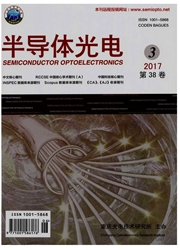

 中文摘要:
中文摘要:
以硅纳米孔柱阵列(Si—NPA)为衬底,通过采用真空蒸镀技术沉积金属锌,再在纯氧气氛中进行氧化退火的方法,制备出具有阵列特征的ZnO/Si—NPA异质结构材料。研究发现,ZnO/Si—NPA的表面形貌、结构和光致发光特性强烈依赖于氧化退火温度。当氧化退火温度低于400℃时,样品的发光主要来自于Si—NPA衬底;当氧化退火温度高于700℃时,样品的发光主要来自于ZnO薄膜;经过600℃氧化退火的样品则同时包含有来自于Si—NPA和ZnO薄膜的发光。上述结果表明,通过控制ZnO/Si—NPA制备过程中的氧化退火温度,可以在一定程度上实现对其光致发光谱的有效调控。这对未来制备具有特定功能的半导体光电器件具有重要的实际意义。
 英文摘要:
英文摘要:
Regularly arrayed zinc oxide/silicon nanoporous pillar array (ZnO/Si-NPA) heterostructure was prepared by evaporating zinc atoms on Si-NPA substrate followed by an annealing process in pure oxygen environment. It was found that the morphology, structure and photoluminescence(PL) of ZnO/Si-NPA highly depends upon the annealing temperature adopted in sample preparing process. When the annealing temperature is below 400℃ or above 700℃, the PL would be mainly attributed to the light emission from Si-NPA substrate or ZnO film, respectively. PL originating from both Si-NPA substrate and ZnO film is simultaneously observed in the sample prepared with an annealing temperature of 600℃. Our experimental results show that to a degree, the PL could be effectively controlled through changing the annealing temperature adopted in the preparing process. This might be of practical importance in fabricating optoelectronic devices.
 同期刊论文项目
同期刊论文项目
 同项目期刊论文
同项目期刊论文
 期刊信息
期刊信息
